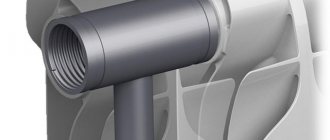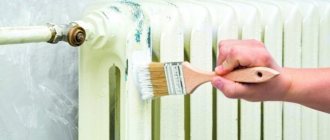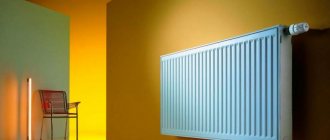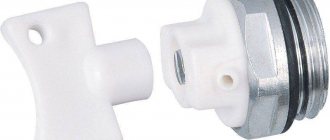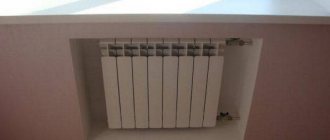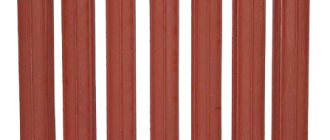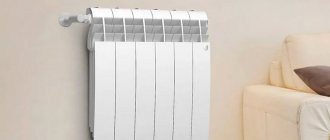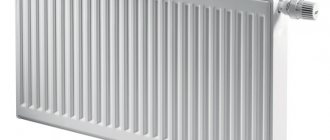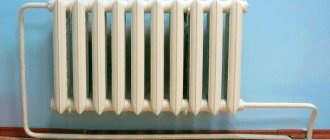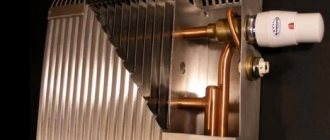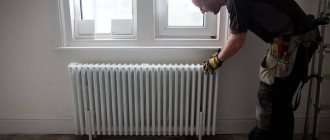Rating:
395
In order not to freeze on cold winter evenings, you need to take care in advance about heating your home, as the popular proverb says: prepare your sleigh for winter in the summer. To solve this issue, the ideal options are panel ones.
Owners of country houses are paying more and more attention to panel heating radiators made of steel. Their heat transfer rate is very high. And, if you compare them with devices of other types, this advantage becomes very noticeable. Panel radiators are produced in different sizes, which allows them to fit into the interior of any room. The power parameters of panel batteries are different.
Heating battery panel devices are designed in such a way that two sheets are located in the center, welded together. The sheets are cut with channel grooves. These grooves are needed for coolant circulation. The radiator sheets are covered with a grille on top. Its shape is U-shaped. The role of this grille is to increase the level of heat transfer.
Sectional panel radiator
The top layer is covered with a decorative panel. The width of the radiators varies: from forty to three hundred centimeters, while their height reaches from thirty to ninety centimeters. As you can see, the dimensions and design of panel radiators allow them to be located in any room, even the smallest areas.
Kinds
The degree of power parameters of a panel heating radiator is associated with the peculiarity of its design, with the number of connected panels. Each radiator device has a marking that contains all the information characterizing each device and will show how each heating device differs from each other.
Types of panel radiators
Let's look at some types of panel radiators:
- Type 10. The first number means there is one panel. Zero indicates the absence of ribs. One steel plate that has no side walls and no grille to release air. This is what this species is all about.
- Type 11. Two units indicate the presence of one panel and one row of ribs, which is welded to the back.
- Type 20. This device is represented by two panels and a complete absence of ribs.
- Type 21. It has two rows in depth, that is, two panels plus a row of ribs between them.
- Type 22. The depth is two panels, two rows of ribs, each row of ribs is welded to one of the two sheets.
- Type 33. The deepest type. It is represented by an assembly of three sheets and three rows of ribs located inside the panels. In cross-section it would look like this: leaf – ribs – ribs – leaf – ribs – leaf. Each row of ribs is attached to one panel.
Depending on the model type of radiator, connection methods are distinguished: side and bottom. A radiator with a side connection option can be connected from either side. doing it yourself is not difficult at all. Connecting radiators from below is considered more acceptable.
A thermostatic valve is included in the battery components upon purchase. Its task is to help regulate the heating temperature in the room. It operates manually. Installed directly on the device itself. The bottom connection of a panel radiator has the advantage of being able to hide the supply lines in the floor or walls. In terms of price, it will certainly be more expensive.
When purchasing, it is important to pay attention to the battery power of the devices. Correct calculation of radiators will avoid difficulties in the future.
Calculation of the power of panel radiators
If you buy panel batteries for heating without special calculations, and they turn out to be inappropriate for a given room, this will affect the quality of heating.
The heating device cannot be supplemented with anything. It would be good if they accepted him back and gave him another one in return. Otherwise, you will end up wasting money, since you will still have to buy another one.
To make the correct calculation of radiator power, you need to go through two steps:
- Correctly calculate the area of the entire room and its volume.
- Multiply the figure obtained by measuring the volume by forty-one watts.
Forty-one watts represents the power level taken as an average. This is how many watts of power are needed to heat one cubic meter of room. A corner room will require significantly more power.
The advantages of this type of radiator:
- A small volume of water is required for operation,
- high heat transfer,
- the price is available to anyone who wants to purchase them,
- light weight, which does not require much effort during installation,
- Another plus is their pleasant appearance, shape, color, variety of sizes.
In addition to their advantages, panel heating radiators also have disadvantages. This is evidenced by the reviews of those owners who remain, who are somehow dissatisfied with their operation. Therefore, before purchasing heating devices, read reviews from other buyers.
Disadvantages of panel radiators for apartment and house heating systems:
- Do not buy panel heating radiators if the house is left without water for a month or more. They must always be filled with liquid, otherwise oxygen contact with the radiator wall occurs inside them.
- The heating devices described above require little pressure during operation. The maximum level allowed for this type of device is nine atmospheres.
- According to their characteristics, these devices are suitable for low-rise buildings. Consequently, they will find ideal use in a house outside the city.
- Test the water to determine its hydrogen content. This is due to the fact that these devices are subject to corrosion, and every owner needs a stably operating device. With traditional heating, there is no way to control the level of hydrogen in the water. The high level of pressure existing in the heating system of a multi-storey building and the resulting water hammer will quickly destroy such radiators, which is very undesirable to happen during the winter cold.
So, having become acquainted with the technical characteristics of panel radiator devices for home heating, having studied all the reviews, having measured the volume of the rooms, go shopping. Do not forget to also look at the thickness of the metal, the type and dimensions of the radiator when purchasing.
Your contacts in this article from 500 rubles per month. Other mutually beneficial options for cooperation are possible. Write to us at
Steel ones are widely used for heat supply to private homes and offices. These devices are made in the form of a rectangular panel, tubular structure or sections. Their main advantage is low weight and high heat transfer.
A steel radiator is well suited for heating rooms with an autonomous heating unit. But before installation it is important to calculate the pressure. Thus, such systems are not suitable for heating apartments in high-rise buildings precisely because of the pressure: reaching 25 atmospheres, it can damage the heating device.
Difference between cast iron and bimetallic batteries
Radiators, consisting of two types of metals at once, came to the domestic market from Italy and quickly won the hearts of consumers, despite their high cost. This can be explained in one word: “reliability”. If you choose which is better, cast iron or bimetallic batteries, then you should compare their technical indicators:
- Structure:
- Cast iron structures now look stylish, but they are also assembled from sections equipped with a fairly wide channel for the coolant. Their weight has become significantly less (3.5 kg versus 8 kg previously), their appearance is more presentable, and their reliability is the same. The market offers classic sectionals and artistic, retro style ones. The latter are very expensive, and mostly imported.
- Bimetallic structures consist of a steel or copper core with aluminum fins and housing. The coolant comes into contact exclusively with stainless steel, which protects the device from corrosion, and the casing ensures high heat transfer. Such a heater weighs little, is easy to install, and additional thermostats allow you to monitor the heating of the coolant.
- Heat dissipation level:
- If you decide whether cast iron or bimetallic radiators heat better, then their performance will be approximately equal. So the heat transfer of a cast iron section ranges from 100 W to 160 W. Many consumers feel that they take too long to warm up, and they are right. At the same time, everyone forgets that these batteries also take a very long time to cool down.
- The heat transfer of one section of a bimetallic radiator is 150-200 W, which, with instant heating, brings this type of heaters to a leading position.
- Operating pressure:
- Although many years of experience in using cast iron batteries suggests that they are strong and reliable, this is not entirely true when it comes to high-rise buildings. Even in five-story buildings, quite strong water hammers can occur in the heating system, let alone buildings of 16 floors and above. The operating pressure of cast iron batteries is 9-12 atmospheres, which may not be enough if the pressure rises sharply, for example, up to 15 atmospheres. In this case, the cast iron sections will simply burst.
- Bimetallic radiators are more reliable, since their operating pressure is 25-40 atmospheres, and in some models even 100 atmospheres. At this point, designs made of two types of metal also lead.
- Coolant resistance:
- Cast iron is absolutely “indifferent” to the quality of water and its acidity. Completely draining it in the summer does not affect it, but the pebbles that sweep through the system gradually weaken the cast iron, drain it and render it inoperable. This process is lengthy, and if the radiator walls are thick enough, it is completely endless.
- A bimetallic radiator is weaker in this regard. It is not afraid of the acidity level of the water as long as it is in the system, but as soon as it is drained, corrosion begins to appear after 2-3 weeks of contact with air. In this indicator, bimetal loses to cast iron.
- In terms of temperature, both types of radiators tolerate temperature changes well. For cast iron, the maximum water heating is +110, and for bimetal - +130 degrees.
- Today you can find cast iron batteries whose age has exceeded 100 years, but on average they have a service life of 50 years. Manufacturers set a limit of 25-30 years for bimetallic radiators, which is less than that of cast iron.
Bimetallic heaters are the best option for replacing old batteries. In key respects, they are superior to cast iron devices, which guarantees their effective operation in the unfriendly environment of centralized heating. In addition, they are much easier to install, they are lightweight and do not require additional maintenance.
If the question is whether to replace cast-iron radiators with bimetallic ones or not, then residents of five-story buildings do not have to do this, especially since the latter devices are twice as expensive. Residents of high-rise buildings will have to abandon cast iron batteries, since they will not withstand the load of the system and will leak. In this option, there is definitely nothing better than bimetallic structures.
Classification
Steel batteries are available in three types:
- tubular - welded structure made of pipes with a working pressure of up to 15 atmospheres;
- sectional - durable sections are connected by spot welding, operating pressure up to 16 atmospheres;
- panel ones are the most popular, they are made of two welded rectangular sheets with stamped recesses.
In panel pipes, the operating pressure reaches 13 atmospheres at a coolant temperature of no more than 110 degrees.
The best known manufacturers and models: characteristics and prices
Panel
Kermi FTV(FKV) 22 500 500
Well-known German panel heating radiators are distinguished by high reliability and quality at a relatively low cost. There are radiators with side (FTV in the name) and bottom (FKV) connections.
Reliability is achieved by the technology of connecting elements, the thickness of steel sheets of 1.25 mm and their quality, as well as painting technology - KEF. As we have already mentioned, this is the most effective painting method, in which the devices are resistant to corrosion and do not emit harmful substances when heated to extreme temperatures.
All radiators in the line have a working pressure of 10 atm, tested with a system pressure of 13 atmospheres. More detailed characteristics are given in the final comparative table.
Buderus Logatrend K-Profil 22 500 500
Another model from an equally famous German manufacturer. It is not inferior in quality to stamping, welding and processing of elements, is equipped with a thermostat to regulate the temperature of the coolant, and at the same time has a lower cost - 80-90% cheaper. However, it has a lower operating pressure - 8.7 atmospheres, which carries a high risk of depressurization when used in a domestic central heating system.
However, radiators are among the best for use in individual heating of a private home.
ELSEN ERK 22 500 500
Panel radiators from a Czech company known for using the latest technologies in the production of heating equipment. The models in the line have increased heat transfer by 25-30% compared to the previously mentioned analogues. During production, the “Low Seams” technology is used: by bending solid sheets, rather than welding their parts, the number of welds, which are the most vulnerable points of steel panel radiators, is reduced.
The heating device is designed for a standard operating pressure of 10 atmospheres, however, the risk of leaks during operation is significantly reduced, and the service life declared by the manufacturer is at least 30 years. Warranty period – 12 years. The disadvantage is the non-standard center distance, for example, for the specified model (height 500 mm) it is 445 mm. This must be taken into account when designing.
Prado Classic 22 500 500
Steel heating devices of the Russian city of Izhevsk. They can withstand operating pressure up to 9 atm, have high heat transfer and resistance to contamination and extreme heating of the coolant (up to 120°C). For manufacturing, steel sheets with a thickness of 1.4 mm are used, which has a positive effect on service life.
The disadvantage is the less aesthetic appearance and the still imperfect quality of the Russian assembly, however, since 2006 (beginning of installation in private and apartment buildings), no serious incidents have arisen during operation.
Tubular
Zehnder Charleston 3050 500 1196
A German manufacturer whose steel tubular radiators are considered one of the best on the market, thanks to time-tested quality. The batteries are capable of operating with a system pressure of up to 10 atm, have an aesthetic appearance and optimal heat transfer.
However, despite the 5-stage treatment, it is necessary to use radiators with caution in a domestic dirty central heating system subject to pressure changes.
Arbonia 2180 1800 540
Tall vertical radiators of another German brand, designed for installation in non-standard places. The radiator is the thinnest among analogs (depth 65 mm), maintaining optimal heat transfer, does not require masking and can be combined with almost any design, focusing attention on itself. On request they can be painted in any color.
View of the model in the interior.
During the practice of operation, no incidents with the quality of the devices were observed.
Sunerzha Estet 500 5008
A model of tubular steel radiators that is gaining popularity on the Russian market. Heating devices have increased heat transfer and an unusual aesthetic appearance. Estet models are designed for a working pressure of 25 atm, which implies use in the most extreme conditions, including in apartment buildings with 10 storeys or more.
View of the model in the interior.
The disadvantage is the huge weight and equally high cost.
KZTO RS 2-500 1150
Another well-known model of Russian-made steel tubular heating radiators, characterized by adaptation to domestic conditions of heating systems. Maximum operating pressure up to 15 atmospheres and coolant temperature up to 130°C are ensured by especially thick walls. Radiators have optimal heat transfer performance and low cost for tubular radiators.
However, according to practice and customer reviews, questions about quality often arise, which, unfortunately, is typical for most domestic manufacturers.
Design overview
A steel panel radiator is a convector, as it promotes the natural circulation of heated and cold air. This is due to the peculiarities of their design - the lower air intake holes take in cold air, and through the holes at the top it comes out already hot. This principle of operation due to the convention allows us to achieve a record efficiency of 75%.
Features of operation
Steel radiators do not heat up as much as cast iron ones, and therefore dust does not burn on them. The hygiene of these devices is ensured by the factory paint spraying method, which also protects them from corrosion.
And what’s important is that you don’t have to paint them; they will retain their appearance for many years. The decorative cladding on panel steel batteries is easily removed, so you can vacuum and wet clean the inside.
Care
Panel heating radiators are made of low-carbon steel, so when the device comes into external contact with water, there is virtually no oxidation or corrosion. Such technical characteristics increase the service life of the device in closed heating systems up to 40 years.
Features of bimetallic radiators
The second option that the store can offer you is a bimetallic radiator. The prefix “bi” in the word “bimetallic” means “two”. This name is given to this type of battery because they are made from two metals: steel and aluminum.
Let's immediately turn to the positive characteristics of this species:
- The steel in the material from which the body is made will perfectly withstand any surges in water pressure. It is also not subject to corrosion. These properties of the metal ensure high strength and many years of faithful service of the device;
- steel sheet provides serious protection of the case from external mechanical damage;
- active coolant circulation;
- Aluminum coating will ensure rapid heating of the air in the living room;
- battery operating pressure can reach 40 atm;
- the maximum possible coolant temperature is approximately 130 degrees, while for aluminum products it is only 110;
- durable paint coating on the body. This stability is achieved through a two-stage dyeing mechanism:
- First of all, the product is placed in a dye solution and completely covered with paint;
- Then another polymer layer based on epoxy resin is sprayed on top of the dried first paint. Radiators processed using this technology not only look very aesthetically pleasing, but also take on clearer geometric shapes;
easy installation and transportation, especially if you seek the help of professionals. The design of bimetallic batteries is no more complicated than that of simple aluminum ones, however, their installation is also best left to professionals. How long the batteries are installed correctly, the longer they will serve you; the ability to add additional sections directly to your home
However, if you assume that you still want to increase their number, when purchasing, pay attention to the design of the radiator housing. Some of the models on the market have a solid steel core, so they are not divided into sections.
Bimetallic radiator section
One of the options for the appearance of a bimetallic radiator
Let's pay attention to the disadvantages of bimetal devices:
- aluminum used in combination with steel loses its high heat-transfer properties. Due to the steel core inside the battery, you will have to wait a little longer than you are used to for the air to reach the desired temperature;
- increased price. Since the price of steel is higher than silicon, the cost of bimetallic batteries also increases by about 30% compared to aluminum ones;
- increased operating costs. Since bimetallic devices boast increased hydraulic resistance, the amount of energy spent on water circulation will also increase;
- Improper use of radiators can lead to corrosion of its steel parts. This will definitely happen if bimetallic batteries are installed in your dacha, which is not used in winter. As soon as the autumn heating season comes to an end, it will be necessary to carry out the procedure of draining the water from the system. It is because of this that corrosion processes will begin: simultaneous contact of steel with air and water instantly starts them.
- The small tube passage inside the device is subject to rapid clogging. This shortens the service life of the device.
Important! The coefficients of thermal expansion of steel and aluminum differ, which is why the battery begins to emit loud crackling sounds after a short period of time. This sound does not mean that there is a problem inside the device.
Don't worry, your health is safe!
These modern radiators can function properly even in rooms where the air humidity level is high. Their surface is resistant to corrosion. The radiator is given such resistance to aggressive environmental influences by sheet steel, which covers the body of the device with a protective layer.
Inside bimetallic radiators there are water channels of small cross-section. Due to their modest size, they are filled as quickly as possible with hot water coming from a centralized water supply system or an autonomous boiler.
Construction professionals consider purchasing bimetallic batteries and installing them during renovations as one of the best functional improvements to an apartment. Over time, the use of these devices will fully pay for the money spent on them.
Connection
The standard battery kit, as a rule, already includes everything necessary for its installation: dowels, fasteners, adapters, plug and Mayevsky tap.
Methods
There are four ways to connect a steel radiator to the heating system:
- bottom connection is considered the most optimal: the pipes will be practically invisible, and the built-in thermostatic valve will allow you to independently regulate the air temperature level in the room;
- diagonal (cross) connection - the hot water supply pipe is connected on one side of the radiator from the top, and the return pipe is located on the other side from the bottom;
- lateral connection - used to connect radiators to vertical risers of the heating system and is more often used in multi-storey buildings;
- universal connection - the design of the batteries has holes on the top, sides and bottom, which allows them to be used for any connection.
General information
Some people ask this question: what should you first pay attention to when choosing steel ones?
The range of steel heating devices today is very diverse. On the one hand, there is plenty to choose from, but on the other hand, a large selection can cause a feeling of confusion. Steel radiators, first of all, may differ by manufacturer. They may also vary in color, size, price range, size or design features. Today, steel radiators are a completely worthy replacement for cast iron radiators, which were the leader in popularity not so long ago.
A steel radiator is a heating device that is a single rectangular panel made of two steel sheets. These sheets are welded together and have channels for water.
Steel radiator design
It is not recommended to install steel heating radiators in rooms where there is a high level of humidity, so they are not suitable for a bathroom. Today, steel heating devices can be seen not only in private homes, but also in shops, offices, and country cottages. This is due to their low cost, and at the same time, beautiful and stylish design.
Before deciding on the choice of device manufacturer, you need to find out what manufacturing method was used. Proper manufacturing techniques involve manufacturing the device itself, painting it, assembling it into blocks and packaging it.
The cost of steel heating radiators primarily depends on their power ratings and size. Sometimes some steel radiators with similar parameters are more expensive than others, only because of the more popular brand. Therefore, think about whether it is worth paying the extra money. Of course, domestic devices will cost slightly less than those produced in Europe. But in terms of size and operating parameters, they may not differ or may differ, but not significantly.
Classification and sizes of steel radiators
In order to choose the most suitable radiator, you need to take into account the following nuances:
- More uniform heating of the entire room depends on how deep and low the heating device is located.
- It is necessary that the radiator be equipped with an element such as a Mayevsky valve, as this will make it possible to bleed excess air from the system. It is also advisable that the radiator be equipped with water interruption taps. Unforeseen emergency situations may arise, and such cranes will come in handy.
- If a heating radiator is installed under a window, then its width should be no less than 50-70% of the width of the window opening.
- To make the heating radiator more practical, you can choose a model that is equipped with a thermostat. Such an element can be either manual or automatic.
Requirements for installing a heating radiator
Dimensions
- height – 300, 350, 400, 500, 600 and 900;
- width – from 400 to 3000.
If necessary, you can select devices of non-standard sizes.
Increasing the heating area
To increase heat transfer, steel ribs - U-shaped plates - are welded to the panels. The number of plates increases the power of the radiator, as the heating area increases. Depending on the quantity, radiators are divided into three types:
- low power 11 – one plate;
- average power 22 – two plates;
- powerful radiators 33 – three plates.
Characteristics of electric radiators.
There is an alternative to central heating, it is an electric heating system. Such a system has a number of advantages: it heats well, is extremely easy to install, compact, and silent in operation. It is worth noting that an electric heating system is more economical than central heating and other heating systems, because... the cost of installing the system and the energy spent working is significantly lower. It is possible to regulate energy consumption depending on the time of day and outside temperature, which also contributes to savings.
Advantages of electric radiators:
Easy installation of the heating system; The system is environmentally friendly; Saves space because
electric heating radiators are very compact; The safety of using an electrical appliance is ensured thanks to the presence of special sensors; Fully autonomous operation with a standard supply voltage of 220 V; Thanks to their design, electric batteries will harmoniously fit into any interior; It is possible to select the number of electric battery sections, depending on the room parameters. Please note that it is necessary to decide on the choice of heating system at the building design stage. The main disadvantage of an electric convector is the cost of electricity
Electricity consumption directly depends on possible heat losses in the room - doors, type of double-glazed windows, window area, size and quality of room insulation
The main disadvantage of an electric convector is the cost of electricity. Electricity consumption directly depends on possible heat losses in the room - doors, type of double-glazed windows, window area, size and quality of room insulation.
Conclusion: If you are the owner of private houses and apartments that are equipped with autonomous heating systems, you can choose batteries based on your aesthetic preferences and financial capabilities, since the risk of water hammer in autonomous heating systems is usually small, and the coolant is of fairly high quality.
Design
A steel panel radiator can become not only a source of heat, but also a stylish piece of furniture. In addition to the traditional white color, there are radiators on the market in a variety of colors, even with patterns.
Steel panel radiators can be “packed” into decorative boxes - screen and sidewalls, which... Decor for heating devices can be made to order according to an individual design or purchased ready-made from the manufacturer.
New items
Tubular heating radiators, due to the shape of the pipes, can be of a wide variety of designs: both classic options and bold interior experiments are available for them.
For example, a new popular design made of heating pipes has entered the market - bench radiators covered with varnished boards. This bench can be installed in the hallway, kitchen, children's room or winter garden. Its compliance with hygienic standards allows it to be placed in medical institutions.
Dimensions of steel radiators
In the USSR, heating radiators were traditionally made from cast iron. Consumer fashion for aluminum, bimetallic and steel radiators appeared relatively recently. Therefore, among these products the most common are products from European manufacturers. Accordingly, such radiators have a European system for classifying dimensions and sizes:
- Type 10 – one row, no fins, like cladding;
- 11 – one row with fins, without cladding;
- 20 – two rows without fins;
- 21 – two rows with fins, cladding and grille;
- 22 – two rows with two fins, panel cladding and grille;
- 30 – three rows without fins and with an upper grille;
- 33 – three rows with three panels and an upper grille.
Currently, the most common radiators are types 11, 22 and 33. These radiators have the following dimensions:
- 11— 30x40 cm;
- 11— 90x40 cm
- 22—50x100 cm
- 22— 90x300 cm
- 33— 30x100 cm
- 33—60x100 cm.
pros
A steel panel radiator of any type has the following advantages:
- high heat transfer at low cost;
- the ability to create an interesting design due to a wide selection of colors, shapes and sizes;
- the ability to independently regulate the air temperature and calculate the heating area;
- small volume and weight;
- radiators are resistant to chemical solutions, including alkaline ones;
- optimal combination of radiator and convector properties.
Which manufacturers are worthy of trust?
Today on the market you can see many panel heating radiators of both domestic and foreign brands.
The products of the following companies are most in demand:
Kermi
The devices of this brand are distinguished by high quality and a unique varnish coating made according to a special recipe. They can be used in both one- and two-pipe heating systems.
They have a bottom connection. Equipped with an energy saving mode. The latest Therm X2 technology is used in production.
De'Longh
The equipment of this brand pleasantly surprises with its characteristics - it can withstand pressures of up to 8.7 bar and temperatures of up to 110 degrees Celsius.
Products in the “Standard” line have a side connection, and the “Universal” line has a bottom connection, and they are equipped with a temperature regulator.
Purmo
Purmo radiators are made from high-quality cold-rolled steel. Color scheme – white tone. Temperature limit - 95°C, pressure limit - 10 bar.
Korado
The company produces batteries with both 1, 2 and 3 panels. A wide range of colors, 10 types of design, small volume of coolant, convenient brackets - this is a small part of the advantages of Korado devices.
In conclusion, we note that no matter what manufacturer you choose, it is important to correctly connect the heating equipment, not to confuse anything when installing pipes and taps, and to make sure that the selected device is able to withstand the pressure of the heating system.
Daylux
Turkish Daylux heating batteries have the best consumer qualities. Production facilities provide the ability to produce a wide range of products and the constant availability of all types, heights and connection methods of batteries.
Turkish Deluxe heating radiators have a number of advantages:
- Firstly, the company produces its models only from high quality cold-rolled sheet steel. The use of modern technology ensures quality welding connections, which are the basis for long battery life.
- Secondly, several stages of painting provide reliable rust protection and a smooth surface. The cataphoresis method is used.
- Thirdly, the manufactured products have a wide range of products and two types of connection (side and bottom).
- Batteries have low thermal inertia. They are compact and at the same time characterized by high heat transfer.
Pekpan
Pekpan is a Turkish company that began its history and production of heating batteries in 1972. By the mid-eighties, the manufacturer had become a leader in the production of heating devices for the home.
Turkish Pekpan steel heating radiators are divided into types 11, 21, 22, 33. Therefore, you can easily select a battery for any area.
Heating devices are great for a country house. Steel batteries have a special attractive design, their installation is not difficult. Can be with side connection or bottom connection. Radiators operate without failure in systems with forced coolant circulation.
Steel panel heating radiators Pekpan type 22
Viadrus
Czech cast iron heating radiators Viadrus became known in 1890. The company is steadily developing and improving, therefore, together with its products, it occupies a leading position in the heating engineering market.
Cast iron radiator Viadrus BOHEMIA
Czech cast iron heating radiators are durable and resistant to corrosion, which is especially important for central heating. The devices have a variety of section designs and retain accumulated heat for a long time after the heat source is turned off.
Viadrus heating batteries are designed for heating systems with natural and forced circulation of coolant with temperatures up to 130 °C and a maximum excess pressure of 16 atm.
In the company’s range of radiators you can see the “Thermo”, “Style”, “Kalor 3”, “Kalor”, “Bohemia”, “Diana”, “Hellas”, “Athena”, “Windsor” series.
German and Italian heating radiators are also popular among consumers.
Lammin
Lammin is a leading supplier of engineering equipment for plumbing and heating systems. In Finnish, lammin means “warm”.
The main production line of the company is Lammin heating radiators. Reviews about heating batteries are mostly good. Users note their reliability, good corrosion resistance and reasonable price-quality ratio.
The radiators have a high-tech coloring. The production uses a two-stage painting technology using a special surface preparation technology. The first layer of paint is applied by anaphoresis, the second by spraying high quality epoxy enamel based on polyester. The color used is white RAL 9016.
Lammin heating radiators from Finland have a unique alloy composition, which indicates the high strength of the heating batteries and their long service life. They have greater heat transfer, since everything in them is designed in such a way that the structure has the ability to process the maximum amount of coolant energy for heating the house. Each section of the company's battery has the weight needed for full heat transfer and heat flow capacity.
The internal surfaces of the radiators are coated with zirconium, which protects the structure from corrosion and promotes a long service life without accidents.
Aluminum radiator Lammin PREMIUM AL
In the range of Lammin batteries you can find aluminum heating radiators of the following names:
- Lammin Premium AL-500-100;
- Lammin Premium AL-500;
- Lammin Premium AL-350;
- Lammin ECO AL-500;
- Lammin ECO AL-350.
Bimetallic heating radiators of the names Lammin Premium BM-500, Lammin Premium BM-350, Lammin ECO AL-500-100, Lammin ECO BM-500, Lammin ECO BM-350.
Power and number of sections
The power of steel radiators is determined during production by the manufacturer itself: it is set according to the type of radiator - 11, 22 and 33 - and height - from 300 to 900. The power indicator will be determined directly by these values: as a rule, 1 section works per 1 m2 of heated area premises.
Factors for calculation
The calculation of steel radiators begins with determining the climate: for temperate - a variation of 60-100 W/m2, for northern regions - the norm is from 150-200 W/m2. These calculation sources rarely produce errors. The second criterion for calculation is heat transfer, which can be seen on the packaging or data sheet.
The height of the ceilings also matters - the standard value is 2.7 m, if more or less, then you need to adjust accordingly. To do this, the actual ceiling height is divided by 2.7, and the resulting coefficient is multiplied by the standard power. It is important to remember that when doing it yourself, it is better to take power with a reserve: the heat will “go away” to corner rooms, thin walls and other nuances that a simple user will not be able to take into account.
Simple formula
The calculation is carried out in several stages. An average power value of 100 watts per 1 m2 is taken. If the area of the house is 30 m2, and the power of 1 section of the battery is 180 watts, then the calculations will be as follows: 30 * 100/180, a total of 17 sections will be required to heat a space of 30 m2. If this is a corner room, then this value is multiplied by a factor of 1.2 - i.e. 20 radiator sections.
Heating devices are installed in almost every living space. Usually these are Soviet cast iron batteries, modern aluminum or bimetallic radiators. The house will be warm and cozy if the heating radiators are calculated
and well made.
Depends on several factors:
- technical feasibility of an autonomous or centralized heating system
- coolant quality
- individual choice of the customer, taking into account his idea of the quality of this device
- price policy
Correct calculation of the number of radiators
will provide a favorable microclimate in a heated building. It will provide the owner with the opportunity to independently regulate the temperature in the room. Will help in selecting the ideal heating equipment for your interior. This will be done with optimal calculation of radiators.
Every year the winters in our country become more severe, and many people are increasingly thinking about or installing an additional new one. Every third buyer wants to do it on their own. To do this, they have to face the issue of the size and calculation of heating radiator sections
. Next we will take a closer look at this issue.
Low batteries
Radiators with a small center distance have the following advantages:
- they can be placed under a low window sill;
- they have maximum heat transfer per unit area.
Cast iron radiators
.
The dimensions of the MS-140M-300-0.9 heating radiator sections are:
- length 93 millimeters;
- depth - 140 millimeters;
- height – 388 millimeters.
Due to their smaller dimensions, the heat transfer of cast iron heating radiators is reduced - it is equal to 106 watts from one section at an operating pressure of 9 kgf/cm². Among foreign analogues, there are cast iron products with an interaxal distance along the connections equal to 200 and 350 millimeters; the power of a section of a cast iron radiator of this type is much higher.
Aluminum radiators
. For low batteries made of aluminum, both domestic and imported, the spread of the center distances is quite large. You can find radiator sizes of 150, 300 and even 450 millimeters. Since the possible section length starts from 40 millimeters, the device looks compact and unusual. Low aluminum heating radiators have height dimensions starting from 200 millimeters. The depth of many models compensates for the lack of the other two parameters and is 180 millimeters.
As for thermal power, it varies from a minimum of 50 watts per section to a maximum of 160 watts. The determining factor is the fin area of one section. At the same time, the change in dimensions does not significantly affect the operating pressure - low aluminum devices are designed for 16 atmospheres, and when testing - 24 atmospheres. Bimetallic radiators
. All the sizes of heating radiators that they have are also typical for aluminum heating devices. Thermal power is within the same limits. On sale you can find aluminum low radiators with heat output of 80 and 140 watts per section. The working pressure is 25-35 atmospheres.
Bimetallic low radiators, such as in the photo, have two nuances:
- among heating devices there are batteries not with solid steel cores, but with steel tubes placed between aluminum collectors. Their operating pressure, indicated by manufacturers, is usually 12 or 16 atmospheres;
- they often do not have vertically located channels and, in the case of a lateral connection, can be heated by the collectors due to the thermal conductivity of aluminum. The circulation of the coolant is ensured by the last section, since it is flow-through.
Calculation of the power of batteries, heating radiators
The first thing you need to know is that when calculating the type of heating device, it does not matter whether it is cast iron, aluminum, steel or made of bimetal. The main indicator is the power of the unit. All manufacturing companies must indicate the thermal power of radiators. In case of emergency, knowing the model of the unit, you can always find technical data on the Internet. A little advice: some manufacturers may significantly inflate this figure.
The second thing you need to know is the area of the room that you need to heat. It is important to remember that calculating battery power
must be performed not for the total area of a private house, cottage or apartment, but for each room separately.
Third, the formula for calculating the power of heating batteries
It is extremely simple and anyone can use it. According to SNiP, per 1 square meter of a room with an average ceiling height (2.7 meters) there is 100 W of thermal power. Therefore:
- K – number of sections
- S – area
- P – radiator power
Example: calculating radiator power
for a room of 30 square meters with a standard ceiling height of 2.7 meters. The average power of one section is 180 W. We use the calculation formula: K = 30 * 100 / 180 = 16.7 pieces. Round up to 17, that is, you need 17 sections.
Comparative findings
As the table below compares the heat transfer of heating radiators shows, the most efficient in terms of power are bimetallic heaters. Let us remind you that they are an aluminum finned body with a strong welded frame inside made of metal tubes for the flow of coolant. In all respects, this type of heater is suitable for installation both in heating networks of high-rise buildings and in private cottages. Their only drawback is their high cost.
The heat transfer of aluminum radiators is slightly lower, although they are lighter and cheaper than bimetallic ones. In terms of test and operating pressure, aluminum devices can also be installed in buildings of any number of floors, but subject to: the presence of an individual boiler room with a water treatment unit. The fact is that aluminum alloy is susceptible to electrochemical corrosion from low-quality coolant inherent in central networks. It is better to install aluminum radiators in separate systems.
Cast iron radiators differ sharply from others, the heat transfer of which is significantly lower with a large mass and capacity of the sections. It would seem that with such a comparison they would not find application in modern heating systems. Nevertheless, the traditional MS-140 “accordion” continues to be in demand, their main trump card is durability and resistance to corrosion. Indeed, gray cast iron, from which MS-140 is made by casting, can easily serve for up to 50 years or more, and the coolant can be anything.
In addition, a conventional cast iron battery has high thermal inertia due to its massiveness and capacity. This means that when the boiler is turned off, the radiator remains warm for a long time. As for the operating pressure, cast iron heaters cannot boast of high strength. Purchasing them for networks with high water pressure is risky.
(no votes yet)
How to calculate the power of a panel radiator
P (radiator) = V * 41
- P – radiator power
- V – room volume (height * length * width)
- 41 is 41 W of thermal power required to heat 1 cubic meter of standard construction
For example: a room 6 * 7 meters, with a ceiling height of 3.5 meters. First, we calculate the volume of the room V = 6 * 7 * 3.5 = 147. We use the calculation formula: P (radiator) = 147 * 41 = 6027 W.
We received a figure that means how much heat needs to be given to the battery to warm up a given room. That is, in this case it is necessary to use two 2500 W radiators and one 1000 W radiator. Calculating the number of sections is very simple; just divide the resulting power by the power of one section.
